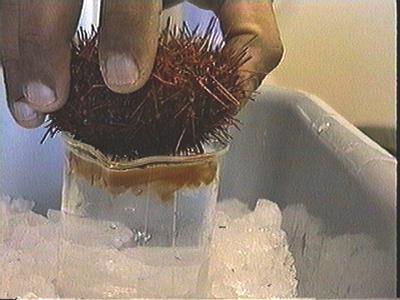7 November, 1996
Journal- November 7, 1996
This morning I helped Gamini with a cytotoxicity assay. We are looking for
chemicals that have the ability to inhibit cell growth. One use for
cytotoxic compounds is in the treatment of cancer. A person who is
undergoing chemotherapy is using drugs that interfere with the reproduction
of cancerous cells.
To perform the assay, a gravid urchin is injected with potassium chloride to
stimulate spawning. Within a few minutes either eggs or sperm will be
released and is collected in a beaker. The urchin in the photo is a female
and a stream of thousands of eggs is being released. The sperm and eggs are
combined in a solution that contains the compound being assayed. If the
compound is not cytotoxic, fertilized will occur and a membrane will appear
around the egg.
After the divers collect sponges, Jim will catalogue and freeze dry all the
samples. It's usually up to Gamini to extract the compounds from the
freeze-dried samples. He then gives the extract to me for a microbial assay.
The assays I perform are designed to determine if the compound will inhibit
either fungal or microbial growth. We have several indicator microbes and
will include others specific to the local environment as Chuck isolates
them. If the results are positive the extract goes back to Gamini or Bill
for further purification until the specific compound that caused the
bioactivity is determined. Of the natural products that have been
identified, only about 1% are used pharmacologically. Of the sponges we have
collected only about 10% have products that are identified to be microbially
active. It seems like the odds of finding something are slim but the
potential rewards are high.
Dom Tedeschi
tedeschid@earthlink.net

Contact the TEA in the field at
.
If you cannot connect through your browser, copy the
TEA's e-mail address in the "To:" line of
your favorite e-mail package.
|
